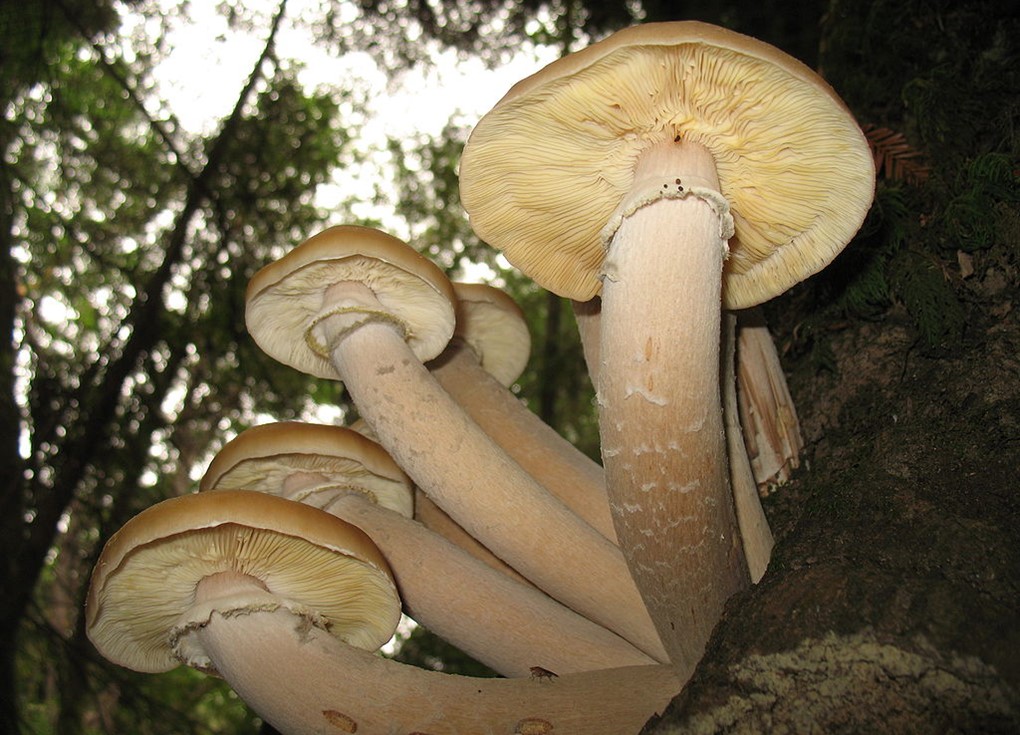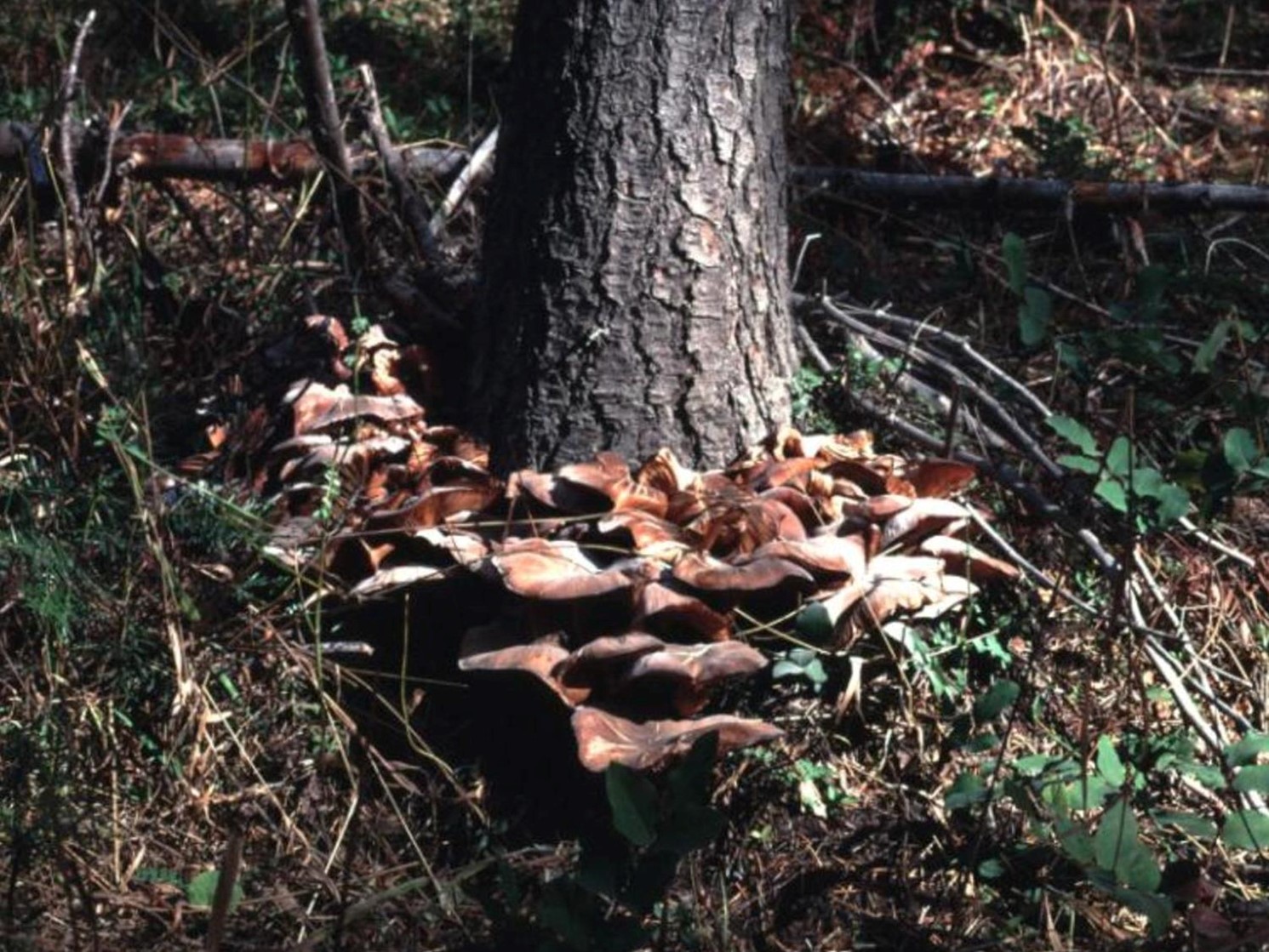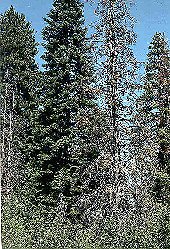
Credit: Alan Rockefeller, CC BY-SA 3.0
Beware, there’s a humongous fungus among us! And if you visit the Malheur National Forest in Oregon, you can walk among it—though you might not know it…
Unless you notice that many of the spruce trees are sprouting mushrooms. And if you DNA tested them, you’d see that each one is genetically identical—because they’re all part of a single gigantic organism, a clonal colony of Armillaria ostoyae, the honey mushroom.
How big is it? Well, the blue whale is the heaviest animal, at 300,000 pounds. We told you on another EarthDate about the heaviest organism, an aspen grove in Utah that weighs 13 million pounds!
But in terms of area, the humongous fungus has them beat. This one organism covers more than four square miles—and mostly underground!
The fungus is a massive network of black rootlike filaments called rhizomorphs. It spreads in the soil from tree to tree, invading root systems and eventually the trunk, where it digests the live wood.
Once it sprouts into mushrooms at the tree base, the damage is already done. When the tree dies, the fungus will digest the dead wood, too. Scientists estimate this one fungus is more than 8,000 years old and still spreading.
If you want to help the forest fight back, you can go and pick some honey mushrooms. When cooked correctly, the humongous fungus … is delicious!
Background
Synopsis: Earth’s largest known organism by area is a fungus the that covers four square miles in Oregon; that’s the size of 1,665 American football fields. It is a parasite that infests and kills conifers as it continually expands around its edges. If you need a whole lot of mushroom gravy this Thanksgiving, its fruiting bodies are edible as long as they are thoroughly cooked.
- If you are trying to identify Earth’s largest organism, it depends on how you define “large.”
- The largest living animal in the world is the blue whale, weighing 300,000 pounds (135 metric tons) or more, heavier than the largest of the dinosaurs. (ED-071 The Curious Tale of Whales)
- Earth’s tallest organism is “Hyperion,” a California Redwood tree that, at more than 375 ft (115 m) tall is 65 ft (20 m) taller than the Statue of Liberty. (ED-284 How Trees Lift Water)
- The heaviest organism is also Earth’s largest plant. Utah’s “Pando” is a quaking aspen colony the size of 80 American Football Fields (106 acres, 43 hectares). With 47,000 trees sprouting from its 80,000-year-old root system, it is estimated to weigh about 13 million pounds (6,000 metric tons). (ED-162 Pando – A Forest of One)
- But the most areally extensive organism is the “humongous fungus” that hides in the Malheur National Forest in the Strawberry Range of Oregon’s Blue Mountains. It covers 20 times the area covered by “Pando.”
- This genetically unique individual Armillaria ostoyae organism, known as a genet, is a parasitic fungus that covers over 2385 acres (965 hectares). That’s more than 4 mi2 (10 km2), or about the size of 1,665 American football fields.

At least five separate A. ostoyae “genets” (unique individual organisms) reside in the mountains east of Prairie City, Oregon in the northeastern portion of the Malheur National Forest. The largest yellow blob on this map is the “humongous fungus,” while smaller genets are also marked in yellow. The Malheur National Forest is shown in green.
Credit: Craig L. Schmitt, Michael L. Tatum (U.S. Forest Service), public domain, via Wikimedia Commons - This humongous fungus is thought to be as much as 8,650 years old.
- Since fungi contain so much water, if you were to include the mass of water in this “humongous fungus,” it might rival Pando for the weight record. Scientists use dry mass to compare the mass of material produced during growth.
- This genetically unique individual Armillaria ostoyae organism, known as a genet, is a parasitic fungus that covers over 2385 acres (965 hectares). That’s more than 4 mi2 (10 km2), or about the size of 1,665 American football fields.
- Fungi grow mostly underground with only their fruit extending above ground; imagine an apple tree buried with only its apples exposed at the soil surface.
- Armillaria ostoyae, also known as “honey mushroom,” prefers to infest conifers like spruce with devastating results to forests.
- By the time bunches of honey mushrooms appear clustered in dense layers at the base of trees, the damage to the host trees is already done.

Armillaria ostoyae mushrooms cluster at the base of a live infected grand fir in Oregon’s Malheur National Forest.
Credit: Craig L. Schmitt, Michael L. Tatum (U.S. Forest Service), public domain, via Wikimedia Commons - While many fungal colonies typically spread through networks of fine translucent to white filaments called hyphae, the honey mushroom has developed black rootlike rhizomorphs that look like shoestrings that extend for miles underground and into the roots and bark of trees, stealing nutrients.
- These fungi digest living wood, then when the trees die, they consume the dead wood, wiping out the entire forest above them as they continually expand outward.

A section of the Malheur forest affected by the “humongous fungus.”
Credit: USDA - Foresters have used clonal analysis and genotyping to map the extent of this remarkable fungal genet between genetically identical patches, intermingled within swaths of dead trees that were victims of its past devastation.
- Scientists muse that it would be fascinating to see what the whole gigantic fungal genet looks like below ground, if the soil was transparent.
- By studying which species of trees are vulnerable to A. ostoyae foresters can better repopulate forests.
- It is possible that these huge, genetically identical, subterranean fungal genets (and Pando) may have lost some of their underground connections through time.
- This species of fungus is faintly bioluminescent, illuminating tales of “foxfire” and “fairy lights” in the Oregon forest for centuries.
- They are edible, but make sure to cook them thoroughly to avoid stomach upset.
- A large genet of Armillaria gallica near Crystal Falls, Michigan covers 91 acres (37 hectares) and is thought to be 1,500-2,500 years old. This more benign species is celebrated in an annual “fungus fest.”

